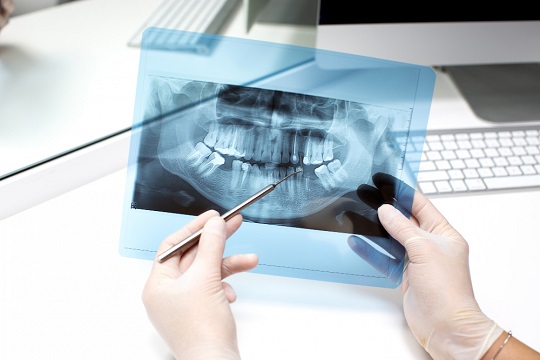Dental X-Rays: Myths And Realities
 Since childhood, you have visited your dentist every year for a routine dental checkup and cleaning. You don’t question the treatment plans recommended by your dentist and dental hygienist: you trust their expertise. But before your most recent visit, you read an alarming article about dental X-rays, and you refused to submit to it.
Since childhood, you have visited your dentist every year for a routine dental checkup and cleaning. You don’t question the treatment plans recommended by your dentist and dental hygienist: you trust their expertise. But before your most recent visit, you read an alarming article about dental X-rays, and you refused to submit to it.
Many people question the taking of dental x-rays and claim to fear the radiation received during these exams.
To reassure you during your next visit to the dental clinic, let’s try to demystify certain myths surrounding this essential step of the complete examination.
Myths And Facts
Now that you know what dental x-rays are for, it’s time to separate the real from the fake:
Dental x-rays are dangerous to your health
Myth
It’s no secret that too much exposure to X-rays is dangerous. To prevent any long-term negative effects on their patients, Quebec dentists take precautions such as:
- Using an apron and lead collar to cover the thyroid gland and reproductive system
- Take only the number of x-rays likely to provide useful information, at the appropriate frequency with the minimum dose of radiation.
Nevertheless, it must be remembered that the gonads or the uterus receive less X-rays during a dental x-ray than during an airplane flight:
- Up to the equivalent of 5 bitewing x-rays per hour.
- Almost the equivalent of 80 panoramic x-rays for a trip to China, since the plane flies over the pole on its route…
- For Cuba the radiation received is less (the equivalent of 10 pans, approximately).
Of course, no one wears a lead apron (imagine the weight!), even though flight attendants and pilots fly several times a week.
Dental X-rays are an irreplaceable diagnostic tool for detecting problems not visible to the naked eye! They can solve or prevent many problems.
Digital Radiology Reduces The Radiation Emitted
Reality
Digital technology makes it possible to produce quality images with considerably (10 times) less x-rays than in our parents’ day.
Digital Radiography Also Has Many Other Advantages:
- The images can be reworked by computer to improve contrast and clarity. Retouching highlights pathologies of bone structures, or teeth, or roots from the same image;
- the waiting time is reduced, the picture can be validated quickly, as with our modern cameras;
- Sharing x-rays — to other professionals, specialists, or insurers for example — is easy: it can be done electronically.
Wearing A Lead Apron Is Necessary During Dental X-Rays
Reality
Even though modern X-ray machines can significantly reduce the rate of radiation exposure, protecting our patients during X-ray examinations remains important. The use of a lead apron and a thyroid collar is part of the basic protocol, for everyone, pregnancy or not, child or adult.
X-Rays Are Necessary At Each Visit To The Dentist
Myths
How often you need x-rays depends on your oral health. It also depends on your usual carious index and your known periodontal condition. An adult in good health (oral and general) who respects the prescribed frequency for their preventive care visits will not necessarily need x-rays at all their dental appointments.
However, if your oral and dental situation is less stable, your professional will have to monitor the changes that occur and you will therefore probably need x-rays more often.
It depends on the judgment of your dentist who has the obligation to offer you the necessary examinations.
A Different Frequency For Each Type Of X-Ray And For Each Person, At Each Stage Of Life…
Each type of x-ray listed above — as they all have a different function — must be taken at a frequency specific to it. First, according to the standards, a dental record should be based on a panoramic image. If it is not provided when the file is opened or cannot be obtained within a reasonable time, a new panoramic X-ray should be produced.
This X-ray must be interpreted, compared with the previous images obtained and serve as a reference point in the new file. A new shot should be added to the five years (approximately) for an adult and be compared to the previous ones to properly assess the general evolution in your mouth.
Bitewing x-rays should be repeated more frequently. A closer frequency could be recommended if interventions were necessary during this period, or if elements identified remained treated. The periapical radiograph is useful for specific needs, as is the cephalometric radiograph.
Never Do A Dental X-Ray On A Pregnant Woman.
Myth
Do we prevent pregnant women from flying (unless they risk giving birth in flight)? No. However, the dose of radiation transmitted is much higher than during x-rays at the dentist!
We only use radiological examination on pregnant women when absolutely necessary, even if the radiation is very weak and the teeth are far from the pelvic region. Naturally the lead apron will entirely cover the abdomen (and the uterus, and the fetus).
Why such excessive precautions? -Because the field is so sensitive in our modern society that dentists want to ensure that no doubt can worry parents.
…
